
Howittia is a genus of plant containing the single species, Howittia trilocularis, commonly known as blue howittia, and is endemic to Australia. It is a tall shrub found growing in shaded valleys and on rainforest edges, it has hairy leaves and single, purple flowers.

Lasiopetalum behrii, commonly known as the pink velvet bush, is a species of flowering plant in the family Malvaceae and is endemic to southern continental Australia. It is an erect shrub with lance-shaped, narrowly oblong to narrowly elliptic leaves and groups of white to pink and reddish-brown flowers.

Podolobium alpestre, commonly known as alpine shaggy-pea, is a flowering plant in the family Fabaceae and is endemic to south-eastern Australia. It has oblong to egg-shaped leaves and yellow to orange pea-like flowers with red markings.
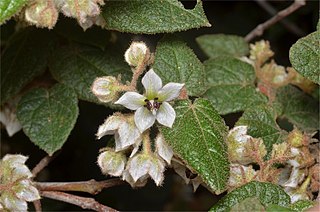
Lasiopetalum schulzenii, commonly known as drooping velvet-bush, is a species of flowering plant in the family Malvaceae and is endemic to southern continental Australia. It is a shrub with heart-shaped leaves and small groups of hairy white and reddish-brown flowers.

Podolobium ilicifolium, commonly known as prickly shaggy-pea, is a flowering plant in the family Fabaceae and grows in eastern and southern Australia. The inflorescence is a cluster of yellow or orange pea-like flowers with red markings and shiny green, prickly foliage.
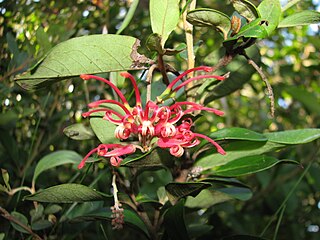
Grevillea miqueliana is a species of flowering plant in the family Proteaceae and is endemic to Victoria in Australia. It is an erect to spreading shrub with elliptic to egg-shaped leaves and clusters of red and orange or yellow flowers.

Oxylobium ellipticum, commonly known as the common shaggy-pea, is a flowering plant in the family Fabaceae. It has dense clusters of yellow pea flowers and elliptic-shaped leaves. It grows in south-eastern Australia.

Oxylobium arborescens, commonly known as the tall shaggy-pea, is a species of flowering shrub to small tree in the family Fabaceae and is endemic to south-eastern Australia. It has elliptic dark green leaves and yellow pea flowers.

Pultenaea densifolia, commonly known as dense-leaved bush-pea, is a species of flowering plant in the family Fabaceae and is endemic to southern continental Australia. It is a spreading or low-lying shrub with broadly egg-shaped, down-curved leaves and clusters of purple or yellow, red and purple flowers.

Podolobium aciculiferum, commonly known as needle shaggy-pea, is a flowering plant in the family Fabaceae and endemic to eastern Australia. It has stiff, pointed leaves and yellow pea-like flowers with red markings.
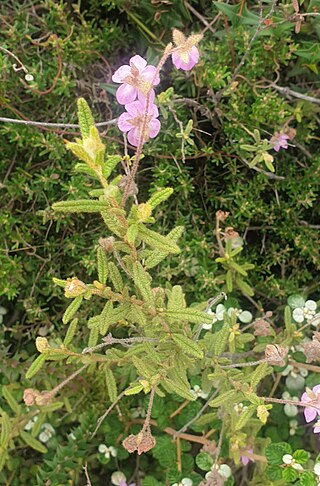
Thomasia petalocalyx, commonly known as paper flower, is a species of flowering plant in the family Malvaceae and is endemic to southern Australia. It is a shrub with wrinkled, oblong to egg-shaped leaves and cup-shaped mauve flowers.
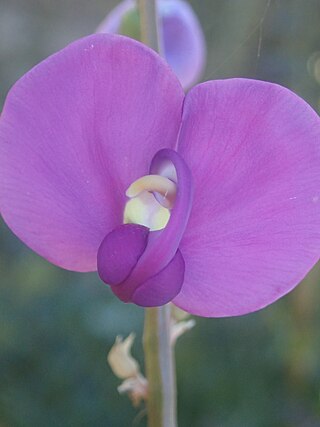
Swainsona procumbens is a plant in the pea family (Fabaceae) native to Australia and found in New South Wales, Victoria, Queensland and South Australia.

Oxylobium cordifolium, commonly known as the heart-leaved shaggy pea, is a species of flowering plant in the family Fabaceae and is endemic to New South Wales. It is a small, prostrate shrub with long, wiry branches, heart-shaped leaves and orange-red flowers.
Pultenaea benthamii, commonly known as Bentham's bush-pea, is a species of flowering plant in the family Fabaceae and is endemic to south-eastern continental Australia. It is an erect shrub with sharply-pointed, narrow elliptic to linear leaves and yellow to orange and red flowers in clusters at the ends of branches.
Cassinia ozothamnoides, commonly known as cottony haeckeria, is a species of flowering plant in the family Asteraceae and is endemic to Victoria, Australia. It is an erect shrub with hairy branchlets, linear leaves and corymbs of up to two hundred flower heads.

Pultenaea canaliculata, commonly known as coast bush-pea, is a species of flowering plant in the family Fabaceae and is endemic to coastal areas of southern continental Australia. It is an rigid, spreading shrub with hairy, cylindrical leaves, and yellow and crimson flowers.

Podolobium scandens, commonly known as netted shaggy-pea, is a flowering plant in the family Fabaceae and is endemic to eastern Australia. It is a prostrate, small shrub with orange-yellow pea-like flowers and red markings.

Pultenaea subalpina, commonly known as rosy bush-pea, is a species of flowering plant in the family Fabaceae and is endemic to a restricted area of Victoria. It is a rigid, prostrate to erect or spreading shrub with linear leaves and pink, pea-like flowers.
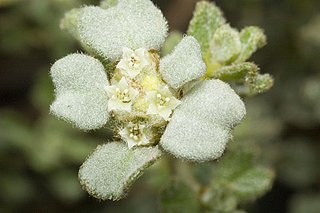
Spyridium halmaturinum, commonly known as Kangaroo Island spyridium, is a species of flowering plant in the family Rhamnaceae and is endemic to Kangaroo Island in South Australia. It is an erect, sticky shrub with densely softly-hairy young stems, leaves that are heart-shaped with the narrower end towards the base to broadly wedge-shaped or Y-shaped, and dense heads of white to cream-coloured flowers.
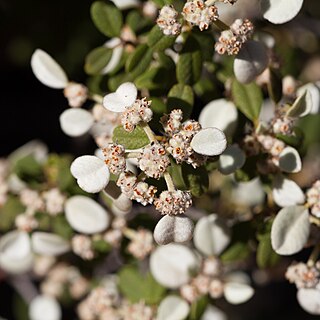
Spyridium phlebophyllum is a species of flowering plant in the family Rhamnaceae and is endemic to South Australia. It is a low shrub with rigid, egg-shaped leaves, and heads of flowers with a velvety, white floral leaf.


















